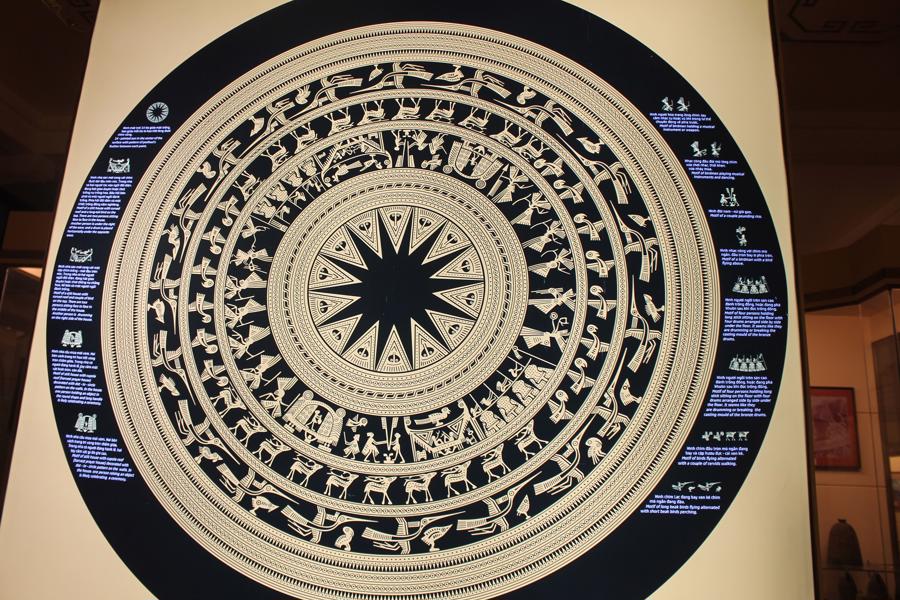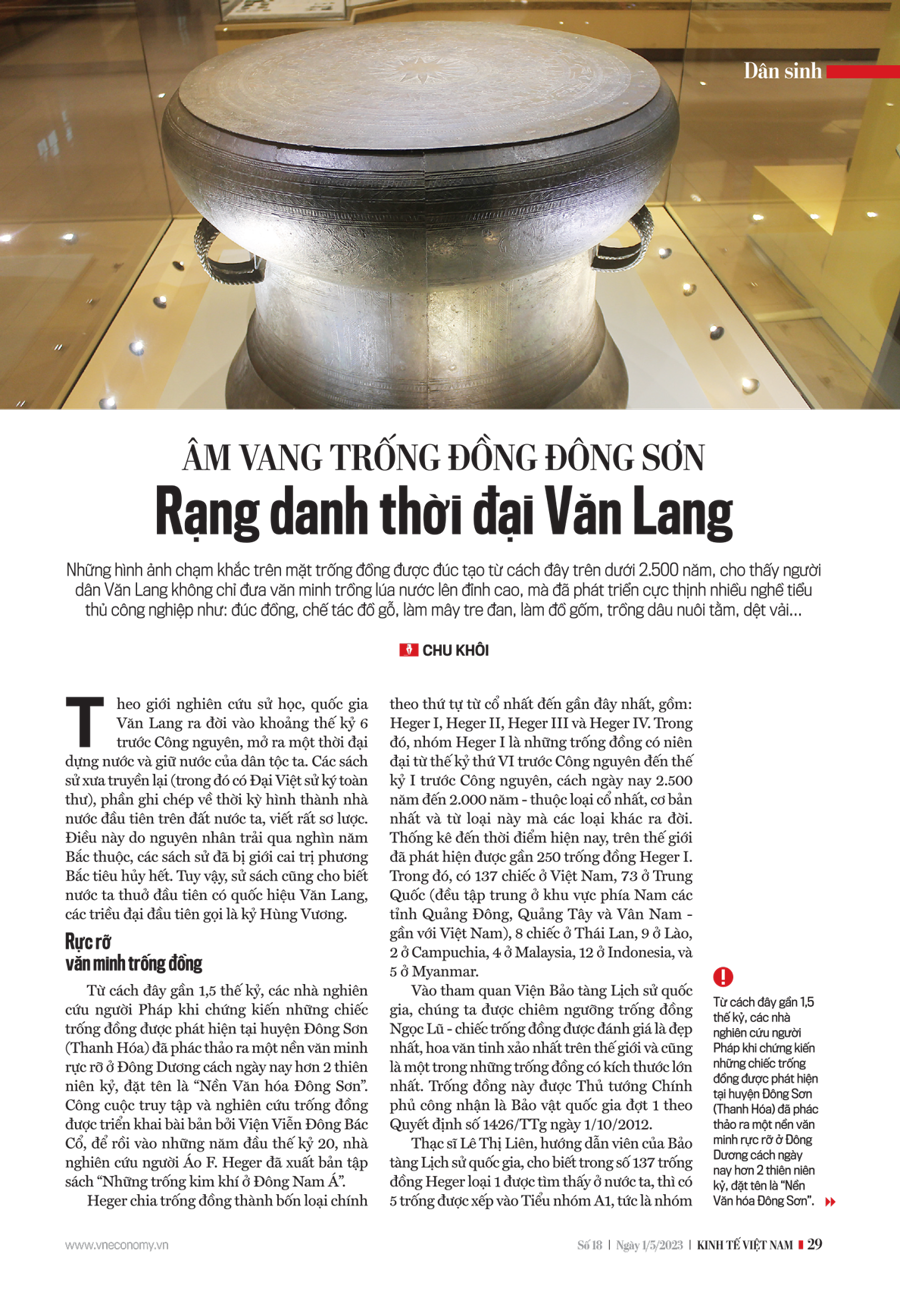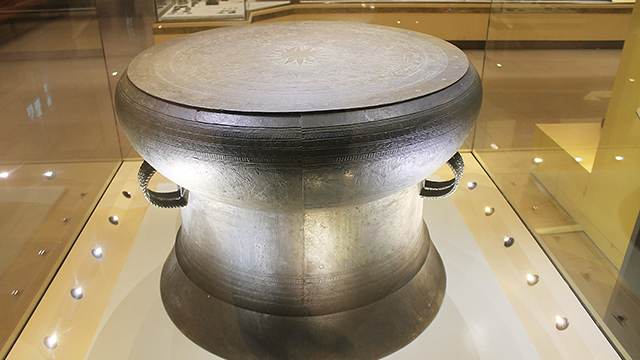[ad_1]
According to historians, the nation of Van Lang was founded around the 6th century BC. Born and ushered in an era of nation building and defense of our nation. The old history books that have been handed down (including the Dai Viet history book toan thu), the records of our country’s first state formation period, are written very succinctly. This is because the history books were destroyed by the Northern rulers after thousands of years of Northern rule. However, history books also say that our country first had the national name Van Lang, the first dynasties called the time of the Hung Kings.
BRILLIANT DRUGS CIVILIZATION
Almost 1.5 centuries ago, French explorers, upon discovering bronze drums discovered in Dong Son district (Thanh Hoa), outlined a brilliant civilization in what is now Indochina, more than two millennia ago, dubbed “Dong Son Culture”. The search and research of bronze drums was methodically carried out by the Institute of the Far East, and in the early 20th century the Austrian researcher F. Heger published the book “The Metal Drums in the Middle East”. Southeast Asia”.
Heger divided bronze drums into four main types, in order from oldest to newest, including: Heger I, Heger II, Heger III, and Heger IV. The Heger I group in particular are bronze drums from the 6th century BC. to the 1st century B.C. B.C., from 2,500 to 2,000 years – they are among the oldest, most basic and from this species. and other species were born.
“According to statistics, the world has so far discovered almost 250 Heger I bronze drums. Of these, 137 are in Vietnam, 73 in China (all concentrated in the southern region of the provinces of Guangdong , Guangxi and Yunnan – near Vietnam) , 8 in Thailand, 9 in Laos, 2 in Cambodia, 4 in Malaysia, 12 in Indonesia and 5 in Myanmar”.
Master Le Thi Lien, National Museum of History.
Visiting the National Museum of History, we can admire the Ngoc Lu Bronze Drum – the bronze drum is considered the most beautiful, the most refined in the world and also one of the largest bronze drums in the world. This bronze drum was recognized by the Prime Minister as the first national treasure under Resolution No. 1426/TTg of October 1, 2012.
Master Le Thi Lien, a guide at the National Museum of History, said that out of 137 Type 1 Heger bronze drums found in our country, 5 drums are classified into the A1 subgroup, that is, the most valuable group (including: Ngoc Lu, Hoang Ha, Song Da, Ban Thom and Quang Xuong). There are 8 drums classified into subgroup A2 (including drums: Mieu Mon, Vu Be, Doi Ro, Lang Vac I, Lang Vac II, Pha Long, Phu Xuyen and Quang Tri).
There are 26 drums classified into subgroup B (including: Duy Tien, Yen Tap, Ngoc Lu II, Phu Duy, Nui Goi, Viet Khe, Lang Vac III, Lang Vac IV, Dinh Cong I, Dinh Cong II, Dinh Cong III , Cuu Cao, Mat Son, Thiet Cuong, Phuong Tu, Pac Ta, Giai Tat, Binh Phu, Hanoi, Hoang Vinh, Vinh Ninh, Dong Son I, Dong Son II, Dong Son III, Dong Son IV, Dao Thinh, Phu Khanh), the rest are bronze drums classified into subgroups C and D.
Specifically, there are 12 Type I Heger bronze drums found in Dong Son District, Thanh Hoa Province, currently preserved in Dong Son Museum and National Museum of History.
Speaking more specifically about the origin and current “whereabouts” of the five most valuable bronze drums – Subgroup A1, Ms. Lien said: Hoang Ha bronze drums were dug into trenches by workers in Noi Village, Hoang Ha Village, Phu Xuyen District. Ha Dong Province (present-day Hanoi) was found in the ground at a depth of 1.6 meters on July 13, 1937. The Hoang Ha bronze drum is currently preserved at the Vietnam National Museum of History. The Song Da bronze drum (also known as the Moulié drum) was invented by the deputy ambassador of Hoa Binh Province (in the second half of the 19th century), Mr. Moulié, from the widow of the Muong Mandarin in the Da River region acquired the province of Hoa. In 1889 the drum was exhibited at an international tournament in Paris and was never returned to Vietnam. The Song Da bronze drum is currently on display at the Musée Guimet, Paris, France.
Exquisite drums
The Thom Bronze Drum was found in Thom Village, Thon Mon Township, Thuan Chau County, Son La Province. This drum is currently kept in the National Museum of History. Quang Xuong drums (purchased in 1934 by a French customs officer named Pajot in Quang Xuong, Thanh Hoa) are now kept in the Vietnam National Museum of History.
The Ngoc Lu Bronze Drum was discovered around 1893-1894 in Ngoc Lu Village (Binh Luc, Ha Nam) when people were building a dike and found a bronze drum on the alluvial sand at a depth of 2 meters. People bring offerings to the community house of Ngoc Lu village. In 1902 the drum was exhibited at a trick fight in Hanoi. The Institute of the Ancient Far East has exported 550 Indochinese silver coins to be bought and stored in Hanoi.
With an artifact date of 2,500 years ago, the Ngoc Lu bronze drum has extremely intricate patterns and has become the leading bronze drum among the finest known Dong Son bronze drums. The drum has a gray-blue patina, 79.3 cm diameter, 63 cm height, 86 kg weight, large. The face of the drum is cast directly from the drum. The drum is arched, the body is cylindrical, and the legs are cone-shaped.

The center of the drum is decorated with a 14-rayed sun, the center of the rays is decorated with a pattern of peacock tail feathers. On the drum surrounding the sun are 16 patterned rings. Rims 1, 5, 11, and 16 are rows of small dots. Rings 2, 4, 7, 9, 13, and 14 are tangent center dotted circles.
Edge 3 is a series of broken N-shaped lines. Rims 12 and 16: are jagged patterns. Ring number 6 is adorned with dancing figures, a domed bridge, a stilt house with a curved roof, a rice pounder, a bronze drumbeat scene… symmetrically through the center.
Ring No. 8 has 2 groups of deer, 20 in total, each group of 10, alternately males and females, alternating between groups are 14 stray birds, with two groups of 6 and 8, counterclockwise. Ring number 10 consists of 36 birds, including 18 flying and 18 sitting, counterclockwise. The rims number 12, 15 have a jagged pattern. The bare face edge has no pattern, has uneven square millet markings.
The drum is the resonator that amplifies the sound. The drum has 10 patterned rings. The upper part of the drum has 6 geometric edges. Rims 1 and 6: small dotted lines lined up. Rims 2 and 5: serrated. Rings 3 and 4: Patterns of concentric circles dotted in the center and connected by parallel tangents. The 7th border is a pattern of people in feathers, racing boats and cormorants, there are 6 boats going left to right, 1st boat has 5 people, 4th boat has 6 people, 2nd boat, 3rd boat , 5, 6 There are 7 people, characters like captain, sailor, helmsman, archer, prisoner killer…
The content of the article was published in Vietnam Economic Review No. 17-2023, published on April 24, 2023. Welcome readers to read The:
https://postenp.phaha.vn/chi-tiet-toa-soan/tap-chi-king-te-viet-nam

[ad_2]
Source link

